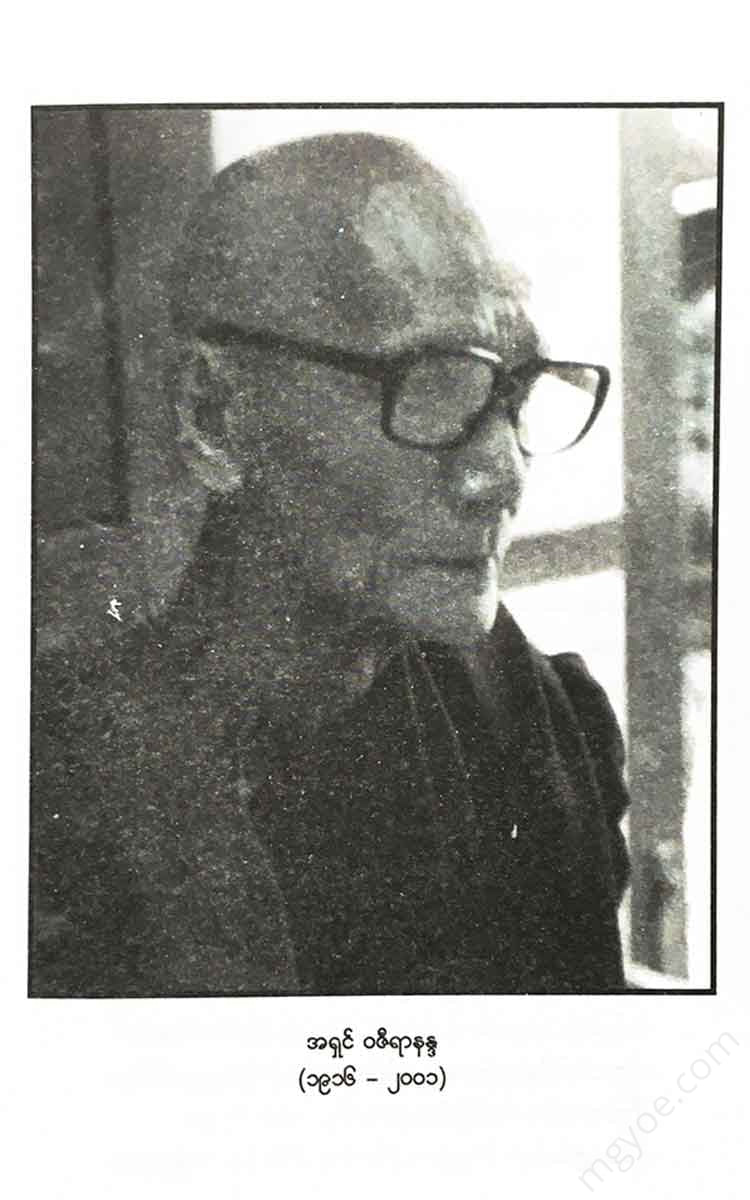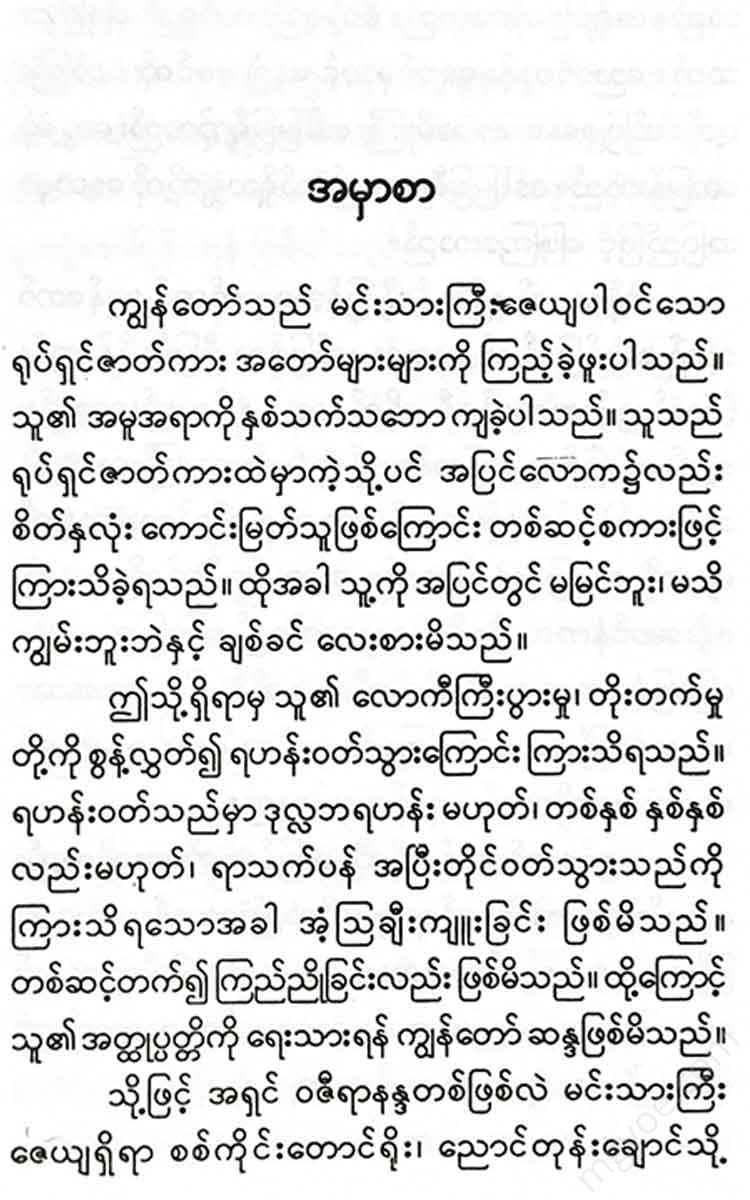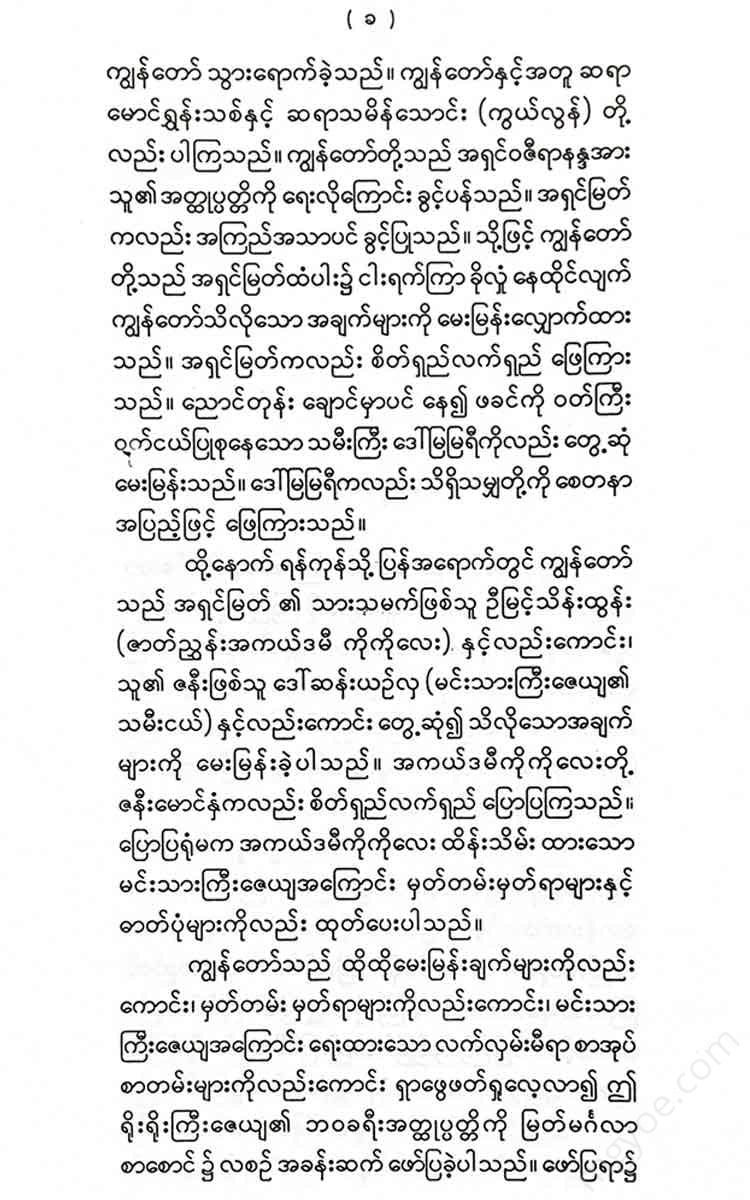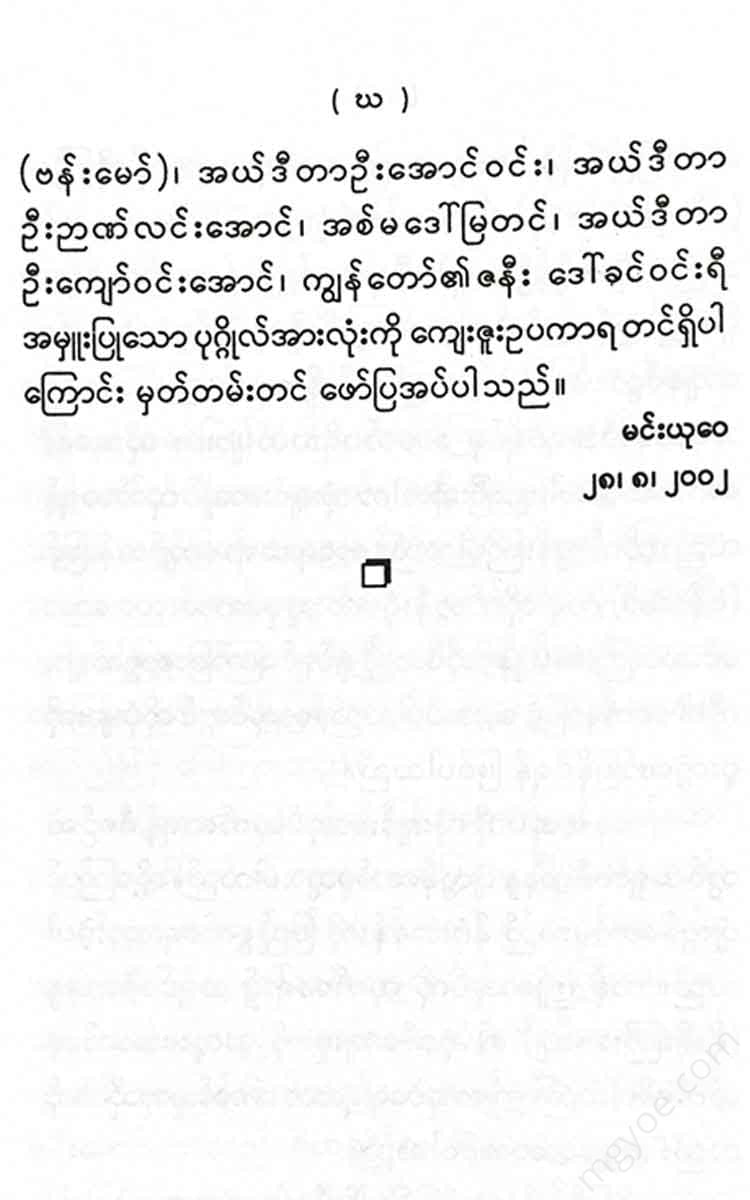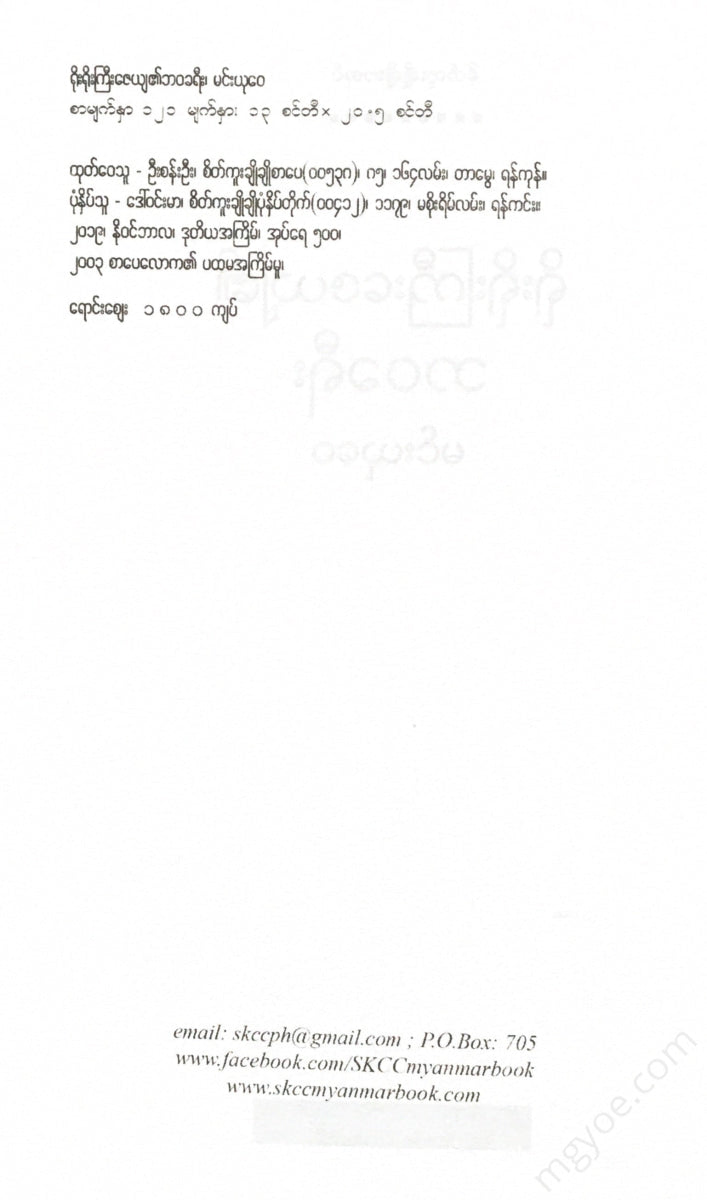စိတ်ကူးချိုချိုစာပေ
Min Yu Wai - The Life Journey of Simple Zeya
Min Yu Wai - The Life Journey of Simple Zeya
Couldn't load pickup availability
Zeyapura also known as Sagaing
Sagaing is a historical city. It was founded in 684 Burmese calendar as the symbol of "Sagaing Tsin" (peaceful circle). The founder was Asanka Saw Yun. It was initially founded under the name of Zeyapura (Aung Myo). It was ruled by successive kings. Later, the name Zeyapura was changed to Sagaing. It has been a prosperous city for generations.
Sagaing is a historical city. As the symbol of "Sagaing is a peaceful place", the Ayeyarwady River flows through Sagaing. In ancient times, the lower part of Sagaing was flooded. In 1889, a large dam was built to prevent flooding. Sagaing has everything from alluvial plains to rocky mountains. The terrain is varied. The Sagaing Mountains range in height from over 700 feet to 1,373 feet.
The Sagaing Mountains are very beautiful. Ancient kings and people of all ages have built caves, schools, and monasteries in the Sagaing Mountains for monks and saints to practice their religion. They have also built shelters for nuns to live in. On every peak, there are pagodas and pagodas. It is very beautiful and pleasant. Around those pagodas and monasteries, there are also various trees. There are also various flowers. There are also various medicinal plants. There are also various birds. It is very peaceful and pleasant.
Nyaung Don Chaong
Among the many peaceful and tranquil lakes in the Sagaing Hills, Nyaung Don Lake is one of a kind. This lake is located on the side of a rocky mountain. It is also located on the side of the Ayeyarwady River. Nyaung Don Lake can be reached by car. It can also be reached on foot. It can also be reached by birdwatching.
If you go by boat, first take a horse-drawn carriage from Sagaing to Tharetpin Port. From there, take a boat to Shinphyu Shinhla Port. If you ride for about half an hour before reaching Shinphyu Shinhla Port, you will arrive at Ashoka Rong Port. Get off at that port and walk for about 10 minutes to reach Nyaungdon Chaung.
Nyaung Don Chaung was formerly a nunnery headed by a nun. Later, when the nun died, it was no longer a nunnery. Before his death, the nun donated it to his grandson, Ashin Tejaw Basa, and it was transformed from a nunnery to a monastery where monks could reside.
Now, the Nyaungdon Monastery, where the monk Ashin Tejaw Basa resides, is scattered with monasteries, schools, and monasteries. In particular, the large rock cave where the monks practice meditation and the large Sakyan monastery where they walk are unique.
A unique monk
There are 10 Waso monks in the Nyaungdon Monastery. Among them, one can see a special monk. That monk has a reverent appearance. He is handsome. He is tall. He has a very calm and peaceful appearance.
Every day, after meditating in the cave, the monk would climb up to the roof of the monastery and walk around with the Dhamma sign. As he walked, he would look up at the Ayeyarwady River. He would often see boats and ships sailing on the Ayeyarwady River. Then he would reflect on human life. “Human beings struggle in various ways to earn a living. Just as boats and ships sail in this way, so too life has ups and downs. Not only in this present life, but also in the journey of samsara, human beings have ups and downs in various lives.” He thought and meditated. He was deeply moved by the Dhamma.
That monk was none other than the venerable Vazirananda, the famous artist and actor Zeyathika, who was once famous throughout the country and loved by the people.
Maung Hla Maung
Prince Zeya's real name was Maung Hla Maung. His father was U Phaung and his mother was Daw Sin. They lived in Nyaung Kone village near Sagaing. Maung Hla Maung was born in that village. He was born on Wednesday, June 12, 1916, the 13th day of the first lunar month of the British era, 1278. He had 11 siblings. Maung Hla Maung was the sixth child. Both parents also sold farm produce. They also worked in the gold-plated paper business.
Gold foil
Gold-plated paper is the paper used to cover the gold-plated gold on the pagoda. This paper was made from bamboo during the time of Maung Hla Maung. After cutting six or seven bamboos without branches or leaves, they were carefully cut, soaked in lime water, wrapped in a cloth, pressed, pressed, soaked in water, pounded, dried in the sun, spread out, and peeled. The whole family worked together to make about two thousand sheets of paper per month.
They sell the gold-plated paper at a rate of one to one and a half kyats per 100 pieces of paper to the Mandalay market. The market then sells the gold-plated paper as gold coins.
While U Phaung Daw Sin's family was working on the gold-plated paper business, they also carried their farm produce such as mandarin oranges, pineapples, and mangoes on foot and on a yoke to the Sagaing market, about two miles away, to sell. Farmers also worked there.
There are about 1,000 households in Nyaung Kone village. There is a stream in the middle. There are about 500 households on the other side. Most of them are engaged in farming, selling their produce, and farming.
U Phaung and his family are the only ones who make gold-plated paper. Even today, their family still makes gold-plated paper. However, it is not the same as in the past. Gold-plated paper is no longer made from bamboo, but from straw. It is not as expensive as bamboo, it is not as laborious, and it is faster. However, it is not as good as paper made from bamboo.
The child who feeds his father
Maung Hla Maung started his education at the monastery in the village. Then he moved to primary school. Maung Hla Maung did not live with his mother for long. When he was seven or eight years old, his mother died. Then the family fell apart. Some got married. Some went to live with relatives. Maung Hla Maung was left alone with his father. His father did not remarry. He even lived with his son. Maung Hla Maung could not make ends meet, and he had to leave school when he was in the third or fourth grade. He carried his farm produce to the Sagaing market, which was more than two miles away, to sell it. At that time, ten pounds of mangoes cost only five to three cents. However, a meal of rice cost only one to ten cents. At the time, a gold coin was worth twelve to thirteen kyats. Maung Hla Maung, a young boy, worked to support his father.
When Maung Hla Maung was born, there was no Sagaing Bridge, also known as the Inwa Bridge. The Sagaing Bridge was built in 1927. It was opened on January 2, 1934. In 1927, when the bridge was built, Maung Hla Maung was only 11 years old. At that age, he participated in the construction of the bridge. Before the large brick pillars were erected in the middle of the river, a brick wall was built on the east bank of the river to prevent the earth from collapsing. To protect the brick wall, the bricks were soaked in water before being laid. Therefore, the bricks were first placed in a large iron tank about 10 feet wide and 5 feet high and soaked in water. After soaking, the bricks were lifted out of the water and then stacked. Since Maung Hla Maung was young, he had to lift the soaked bricks from the iron tank to the top.
“This job doesn’t look too hard, but when you have to pick up the bricks one by one from the water, your hands get wet from the water. There are also small grains of sand on the bricks. If you hold them too long, they will bite your fingers and cause them to bleed, making it impossible to eat with your hands. The wages are six shillings a day. With this wage, I was able to feed my father,” Maung Hla Maung told his friends.
Wearing a korin
After four or five months of working in this way, Daw Aye Myint, a cousin of the elder brother who lived in Mandalay, accepted Maung Hla Maung. He studied literature under the name of Ko Yin from the Sayadaw of Shinpin Nangai Chaung in the Sagaing Hills. The Sayadaw had returned from India and was very good at English. He taught English to Maung Hla Maung and Ko Yin Wuttphet Ko Maung Lay (who became a cameraman for Mandalay Films, now deceased). Maung Hla Maung also wanted to learn English. However, the Sayadaw said, “You are still young. I will teach you Pali grammar first, and then English,” and he began to teach grammar.
Ko Yinkalay Maung Hla Maung has been living the Ko Yin life for about a year now. He intends to continue to wear the Ko Yin robe and become a monk.
At that moment, Daw Aye Aye arrived.
“If you can wear a robe for the rest of your life, it would be good. If you can’t wear it for the rest of your life and you go out into the world, you will encounter difficulties in your journey of life. If you are going out of the world, it would be good to go out early.”
Ko Yin Maung Hla Maung thought deeply about the words of the chief. He considered that it was impossible to live in a robe for the rest of his life. So he left Ko Yin's life. He did not learn English either. He went to the chief's house in Mandalay and lived with him. The chief's family were traders on the ship that went from Mandalay to Bhamo. Maung Hla Maung, who was already thirteen years old, helped the chief's family with all his might. He went to the fairs and checked the prices of goods. He told the chief what kind of goods were at what price. The chief loaded his goods onto the ship at the right price. He sold them. They traveled by ship for a long time. When the ship returned, he was allowed to stay at the Mandalay house for two nights. Therefore, Maung Hla Maung helped with everything. He not only checked the prices of goods, but also did the cooking, preparing dishes, cleaning the pots, preparing the food, cleaning the table, making the bed, making the bed, etc. .
Not only the royal family but also those who interacted with him loved him. They were kind.
“Maung Hla Maung is very kind , has a good heart, is honest, is not lazy, and does any work without complaining.”
They say this both in front and behind.
A daughter of the chieftain set up a tobacco shop and sold it in Bhamo. Every day, ten tobacconists rolled cigarettes. Maung Hla Maung finished all the cigarettes at night and labeled them. He was a man who could do amazing work.


